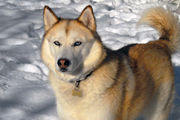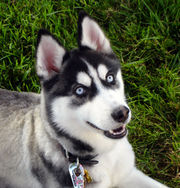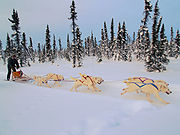Siberian Husky
 |
||||||||||||||||||||||||||||
| A black and white male Siberian Husky | ||||||||||||||||||||||||||||
| Other names | Chukcha, Chuksha | |||||||||||||||||||||||||||
|---|---|---|---|---|---|---|---|---|---|---|---|---|---|---|---|---|---|---|---|---|---|---|---|---|---|---|---|---|
| Nicknames | Sibe, Husky | |||||||||||||||||||||||||||
| Country of origin | Siberia, Russia | |||||||||||||||||||||||||||
|
||||||||||||||||||||||||||||
|
||||||||||||||||||||||||||||
| Dog (Canis lupus familiaris) | ||||||||||||||||||||||||||||
The Siberian Husky (Russian: Сибирский хаски, Sibirskiy haski, "Siberian husky") is a medium-size, dense-coat working dog breed that originated in eastern Siberia. The breed belongs to the Spitz genetic family. It is recognizable by its thickly furred double coat, sickle tail, erect triangular ears, and distinctive markings
Huskies are an active, energetic, and resilient breed whose ancestors came from the extremely cold and harsh environment of the Siberian Arctic. Siberian Huskies were bred by the Chukchi of Northeastern Asia to pull heavy loads long distances through difficult conditions. The dogs were imported into Alaska during the Nome Gold Rush and later spread into the United States and Canada. They were initially sent to Alaska and Canada as sled dogs but rapidly acquired the status of family pets and show dogs.
Contents |
History
The Siberian Husky, Samoyed, and Alaskan Malamute are all breeds directly descended from the original "sled dog."[2] Recent DNA analysis confirms that this is one of the oldest breeds of dog.[3] The term "husky" is a corruption of the nickname "Esky" once applied to the Eskimos and subsequently to their dogs.[4]
Breeds descending from the Eskimo dog were once found throughout the Northern Hemisphere from Siberia to Canada, Alaska, Greenland, Labrador, and Baffin Island.[2]
With the help of Siberian Huskies, entire tribes of peoples were able not only to survive, but to push forth into terra incognita. Admiral Robert Peary of the United States Navy was aided by this breed during his expeditions in search of the North Pole.[2]
Dogs from the Anadyr River and surrounding regions were imported into Alaska from 1908 (and for the next two decades) during the gold rush for use as sled dogs, especially in the "All-Alaska Sweepstakes," a 408-mile (657 km) distance dog sled race from Nome to Candle and back. Smaller, faster and more enduring than the 100- to 120-pound (45 to 54 kg) freighting dogs then in general use, they immediately dominated the Nome Sweepstakes. Leonhard Seppala, the foremost breeder of Siberian Huskies of the time, participated in competitions from 1909 to the mid 1920s.[2]
On February 3, 1925 Gunnar Kaasen was first in the 1925 serum run to Nome to deliver diphtheria serum from Nenana over 600 miles to Nome. This was a group effort by several sled dog teams and mushers. The Iditarod Trail Sled Dog Race commemorates this famous delivery. The event is also loosely depicted in the 1995 animated film Balto, as the name of Gunnar Kaasen's lead dog in his sled team was named Balto, although unlike the real dog, Balto the character was portrayed as half wolf in the film. In honor of this lead dog a bronze statue was erected at Central Park in New York City. The plaque upon it is inscribed,
Dedicated to the indomitable spirit of the sled dogs that relayed antitoxin six hundred miles over rough ice, across treacherous waters, through Arctic blizzards from Nenana to the relief of stricken Nome in the winter of 1925. Endurance · Fidelity · Intelligence[2]
In 1930 the last Siberians were exported as the Soviet government closed the borders of Siberia to external trade. The same year saw recognition of the Siberian Husky by the American Kennel Club. Nine years later the breed was first registered in Canada. Today’s Siberian Huskies registered in North America are largely the descendants of the 1930 Siberia imports and of Leonhard Seppala’s dogs. Seppala owned a kennel in Nenana before moving to New England. Arthur Walden, owner of Chinook Kennels of Wonalancet, New Hampshire, was by far the most prominent breeder of Siberian Huskies. The foundation of his kennel stock came directly from Alaska, and Seppala's kennel.[2]
As the breed was beginning to come to prominence, in 1933 Navy Rear Admiral Richard E. Byrd brought about 50 Siberian Huskies with him on an expedition in which Byrd hoped to journey around the 16,000-mile coast of Antarctica. Many of the dogs were trained at Chinook Kennels in New Hampshire. Called Operation Highjump, the historic trek proved the worth of the Siberian Husky due to its compact size and greater speeds.[2] Siberian Huskies also served in the United States Army's Arctic Search and Rescue Unit of the Air Transport Command during World War II.[5]
Appearance

Siberian Huskies share many outward similarities with the Alaskan Malamute as well as many other Spitz breeds such as the Samoyed, which has a comparable history to the Huskies. They come in a variety of colors and patterns, usually with white paws and legs, facial markings, and tail tip. The most common colors are black and white, copper-red and white, gray and white, and pure white, though many individuals have blondish or piebald spotting. Striking masks, spectacles, and other facial markings occur in wide variety. They tend to have a wolf-like appearance.

Eyes

The American Kennel Club describes the Husky's eyes as "an almond shape, moderately spaced and set slightly obliquely." The eyes of a Siberian Husky are ice-blue, dark blue, amber, or brown. In some individual dogs, one eye may be brown and the other blue (complete heterochromia), or one or both eyes may be "parti-colored," that is, half brown and half blue (partial heterochromia). All of these eye color combinations are considered acceptable by the American Kennel Club.
Coat
The Siberian Husky's coat is thicker than that of most breeds of dogs,[6] comprising two layers: a dense undercoat and a longer topcoat of short, straight guard hairs. It protects the dogs effectively against harsh Arctic winters, but the coat also reflects heat in the summer. It is able to withstand temperatures as low as −50 °C to −60 °C.[7] The undercoat is often absent during shedding.Their thick coats require weekly grooming.[6][8] Long guard hair is not desirable and is considered a fault.
Nose
Show-quality dogs are preferred to have neither pointed nor square noses. The nose is black in gray dogs, tan in black dogs, liver in copper-colored dogs, and may be flesh-colored in white dogs. In some instances, Siberian Huskies can exhibit what is called "snow nose" or "winter nose." This condition is called hypopigmentation in animals. "Snow nose" is acceptable in the show ring.[8][9]
Size
The breed standard indicates that the males of the breed are ideally between 21 and 23.5 inches (53 and 60 cm) tall at the withers and weighing between 45 and 60 pounds (20 and 27 kg). Females are smaller, growing to between 20 to 22 inches (51 to 56 cm) tall at the withers and weighing between 35 to 50 pounds (16 to 23 kg).[8]
Behavior
The Siberian Husky has been described as a behavioral representative of the domestic dog's forebearer, the wolf, exhibiting a wide range of its ancestors' behavior.[10] They are known to howl rather than bark.[11] Hyperactivity, displaying as an overactive hunting drive, a characteristic of kenneled dogs, is often noticeable in dogs released from their captive environment for exercise — a behavior welcome in hunting dogs but not in the family pet. The frequency of kenneled Siberian Huskies, especially for racing purposes, is rather high, as attributed through the history of the breed in North America. They are affectionate with people, but independent. A fifteen-minute daily obedience training class will serve well for Siberian Huskies.[12] Siberians need consistent training and do well with a positive reinforcement training program. They rank 45th in Stanley Coren's The Intelligence of Dogs, being of average working/obedience intelligence. They tend to run because they were at first bred to be sled dogs. Owners are advised to exercise caution when letting their Siberian Husky off the leash as the dog is likely to be miles away before looking around and realizing their owner is nowhere in sight. They also get bored easily, so playing with toys or throwing the ball at least once a day is essential. Failure to give them the attention or proper exercise they need can result in unwanted behavior, such as excessive howling, marking, chewing on furniture, or crying.[13] This dog is sometimes called "the clown of the dogs" after its love to play like a puppy all through its life.
Intelligence
Siberian Huskies are highly intelligent, which allows them to excel in obedience trials, though many clubs would like to keep the Husky's instinct by doing sled-racing.[14] However, because of their intelligence, they can easily become bored and may stop listening to commands. Many dog trainers usually attempt to avoid this behavior by keeping them busy with new activities. Also due in part to their intelligence, Huskies tend to be very observant on the actions of people around them and have been known to mimic common household activities such as turning on lights with their paws and opening doors with their canines. Some undesirable behaviors they can exhibit include opening refrigerators (and eating the food inside), climbing fences or digging tunnels in the backyard to escape.[15] These behaviors can be prevented if the dog is given enough activity to occupy it.
Health
Siberian Huskies, with proper care, have a typical lifespan ranging from twelve to fifteen years. Health issues in the breed are mainly genetic such as seizures and defects of the eye (juvenile cataracts, corneal dystrophy, and progressive retinal atrophy). Hip dysplasia is not often found in this breed; however, as with many medium or larger-sized canines, it can occur.[16] The Orthopedic Foundation for Animals currently has the Siberian Husky ranked 148th out of a possible 153 breeds at risk for hip dysplasia, with only two percent of tested Siberian Huskies showing dysplasia.[17]
Siberian Huskies used for sled racing may also be prone to other ailments, such as gastric disease,[18] bronchitis or bronchopulmonary ailments ("ski asthma"),[19] and gastric erosions or ulcerations.[20]
Working Siberians

Siberian Huskies are still used as sled dogs in sled dog racing. Siberians are still popular in races restricted to purebreds and are faster than other pure sled dog breeds such as the Samoyed and the slower but much stronger Alaskan Malamute. Today the breed tends to divide along lines of "racing" Siberians and "show" Siberians. Racing Siberians tend to have more leg to enable them more reach when running. Show Siberians tend to be a bit smaller.
Apart from sled racing, they are very popular for recreational mushing and are also used for skijoring (one to three dogs pulling a skier) and European ski-hi. A few owners use them for dog-packing and hiking.
In the United Kingdom and Australia, due to the lack of snow, Siberian Huskies are raced on forest tracks using specially designed scooters with two wheels for one or two dogs, or three-wheeled rigs for three or more dogs.[21] This sledding can be a good hobby and sport for a pet Husky. There are many clubs across the world for sledding.
Famous Siberians
Siberians gained in popularity with the story of the 1925 serum run to Nome, which made dogs Balto and Togo famous.
Several purebred Siberian Huskies portrayed Diefenbaker, the "half-wolf" companion to RCMP Constable Benton Fraser in the CBS/Alliance Atlantis TV series Due South.
See also
- Alaskan Husky
- Alaskan Malamute
- Canadian Eskimo Dog
- Laika (dog breed)
References
- ↑ "Siberian Husky Puppies Breeders Huskys Huskies". Puppydogweb.com. http://puppydogweb.com/caninebreeds/siberianhusky.htm. Retrieved 2009-02-02.
- ↑ 2.0 2.1 2.2 2.3 2.4 2.5 2.6 Pisano, Beverly (1995). Siberian Huskies. TFH Publication. ISBN 0793810523.
- ↑ Derr, Mark (2004-05-21). "Collie or Pug? Study Finds the Genetic Code". The New York Times. http://www.nytimes.com/2004/05/21/science/21dog.html?ex=1400472000&en=6b49c839cde80d81&ei=5007&partner=USERLAND. Retrieved 2009-09-14.
- ↑ "The Siberian Husky". Siberian Husky Club of America, Inc.. http://www.shca.org/shcahp2a.htm. Retrieved August 27, 2010.
- ↑ "American Kennel Club - Siberian Husky History". Akc.org. http://www.akc.org/breeds/siberian_husky/history.cfm. Retrieved 2009-02-02.
- ↑ 6.0 6.1 "AKC meet the breeds: Siberian Husky". http://www.akc.org/breeds/siberian_husky/index.cfm.
- ↑ "Siberian Husky Information". Dogbreedinfo.com. http://www.dogbreedinfo.com/siberianhusky.htm. Retrieved 2009-02-02.
- ↑ 8.0 8.1 8.2 "American Kennel Club - Siberian Husky". Akc.org. http://www.akc.org/breeds/siberian_husky/index.cfm. Retrieved 2009-02-02.
- ↑ "Common Husky Questions - Siberian Husky Club of Great Britain - Huskies UK". Siberianhuskyclub.com. http://www.siberianhuskyclub.com/faq/viewsection?sectionID=1§ionName=Health#12. Retrieved 2009-02-02.
- ↑ Hollander, Eric; Dan J. Stein (1997). Obsessive-Compulsive Disorders: Diagnosis, Etiology, Treatment. New York: Dekker. pp. 109–110. ISBN 0824798562.
- ↑ "Siberian husky (breed of dog) - Britannica Online Encyclopedia". Britannica.com. http://www.britannica.com/eb/topic-542620/Siberian-husky. Retrieved 2009-02-02.
- ↑ Childs, Nathan B. (2004). Shaping the Wolf Within Your Dog. Victoria, BC, Canada: Trafford Publishing. pp. 146. ISBN 1412012139.
- ↑ Long, Lori (2007-05-01). Wayne Hunthausen, D.V.M. ed. The Siberian Husky. TFH Publications. ISBN 0793836476.
- ↑ "?". http://www.terrificpets.com/articles/102114265.asp.
- ↑ "?". http://www.allabouthuskies.com/dogsafegardens.html.
- ↑ "Your Siberian Husky: Its Hips and Its Eyes". Siberian Husky Club of America. http://www.shca.org/shcahp4d.htm. Retrieved 2009-09-15.
- ↑ "OFA: Hip Dysplasia Statistics". Offa.org. http://offa.org/hipstatbreed.html. Retrieved 2009-02-02.
- ↑ "Journal of Veterinary Internal Medicine - Journal Information". Jvetintmed.org. http://www.jvetintmed.org/perlserv/?request=get-abstract&doi=10.1892%2F0891-6640%282003%29017%3C0311%3APOGLIR%3E2.3.CO%3B2&ct=1. Retrieved 2009-02-02.
- ↑ "Racing Alaskan Sled Dogs as a Model of "Ski Asthma" - Davis et al. 166 (6): 878 - American Journal of Respiratory and Critical Care Medicine". Ajrccm.atsjournals.org. doi:10.1164/rccm.200112-142BC. http://ajrccm.atsjournals.org/cgi/content/full/166/6/878?maxtoshow=&HITS=10&hits=10&RESULTFORMAT=&fulltext=iditarod&searchid=1&FIRSTINDEX=0&resourcetype=HWCIT. Retrieved 2009-02-02.
- ↑ "Journal of Veterinary Internal Medicine - Journal Information". Jvetintmed.org. http://www.jvetintmed.org/perlserv/?request=get-document&doi=10.1892%2F0891-6640%282005%2919%3C34%3ASSEIIP%3E2.0.CO%3B2. Retrieved 2009-02-02.
- ↑ "Sledding - The Siberian Husky Club of NSW Inc". Siberian Husky Club of New South Wales Inc, Australia. http://sledding.shcnsw.org.au. Retrieved 2010-04-13.
External links
|
||||||||||
|
|||||
|
|||||